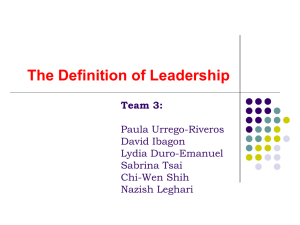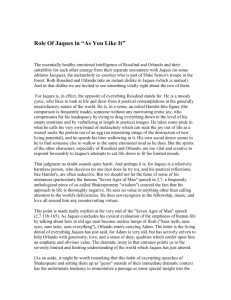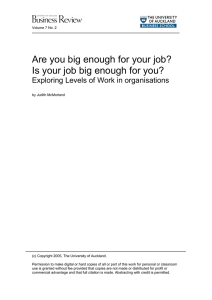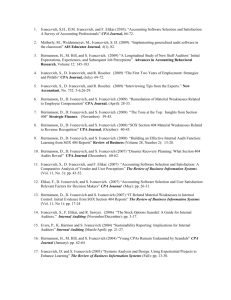Leadership definitions - University of Warwick
advertisement
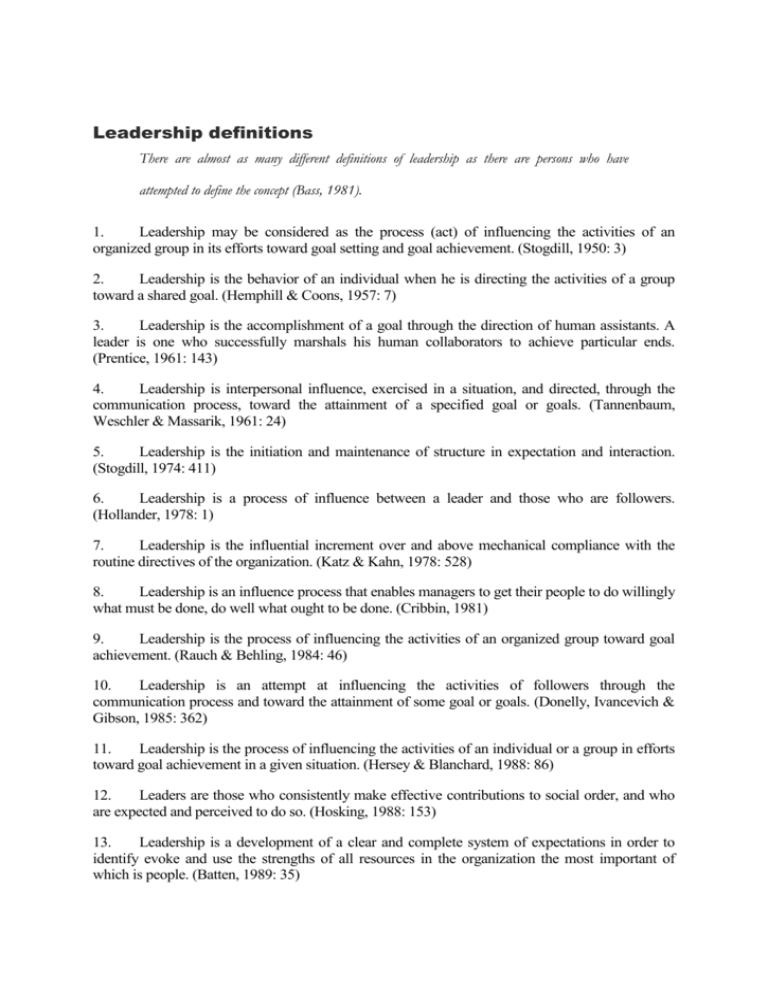
Leadership definitions There are almost as many different definitions of leadership as there are persons who have attempted to define the concept (Bass, 1981). 1. Leadership may be considered as the process (act) of influencing the activities of an organized group in its efforts toward goal setting and goal achievement. (Stogdill, 1950: 3) 2. Leadership is the behavior of an individual when he is directing the activities of a group toward a shared goal. (Hemphill & Coons, 1957: 7) 3. Leadership is the accomplishment of a goal through the direction of human assistants. A leader is one who successfully marshals his human collaborators to achieve particular ends. (Prentice, 1961: 143) 4. Leadership is interpersonal influence, exercised in a situation, and directed, through the communication process, toward the attainment of a specified goal or goals. (Tannenbaum, Weschler & Massarik, 1961: 24) 5. Leadership is the initiation and maintenance of structure in expectation and interaction. (Stogdill, 1974: 411) 6. Leadership is a process of influence between a leader and those who are followers. (Hollander, 1978: 1) 7. Leadership is the influential increment over and above mechanical compliance with the routine directives of the organization. (Katz & Kahn, 1978: 528) 8. Leadership is an influence process that enables managers to get their people to do willingly what must be done, do well what ought to be done. (Cribbin, 1981) 9. Leadership is the process of influencing the activities of an organized group toward goal achievement. (Rauch & Behling, 1984: 46) 10. Leadership is an attempt at influencing the activities of followers through the communication process and toward the attainment of some goal or goals. (Donelly, Ivancevich & Gibson, 1985: 362) 11. Leadership is the process of influencing the activities of an individual or a group in efforts toward goal achievement in a given situation. (Hersey & Blanchard, 1988: 86) 12. Leaders are those who consistently make effective contributions to social order, and who are expected and perceived to do so. (Hosking, 1988: 153) 13. Leadership is a development of a clear and complete system of expectations in order to identify evoke and use the strengths of all resources in the organization the most important of which is people. (Batten, 1989: 35) 14. Leadership is an interaction between two or more members of a group that often involves a structuring or restructuring of the situation and the perceptions and expectations of members…Leadership occurs when one group member modifies the motivation or competencies of others in the group. Any member of the group can exhibit some amount of leadership… (Bass, 1990: 19-20) 15. Leadership is the art of influencing others to their maximum performance to accomplish any task, objective or project. (Cohen, 1990: 9) 16. Leadership is a process of giving purpose (meaningful direction) to collective effort, and causing willing effort to be expended to achieve purpose. (Jacobs & Jaques, 1990: 281) 17. Leaders are individuals who establish direction for a working group of individuals who gain commitment from this group of members to this direction and who then motivate these members to achieve the direction’s outcomes. (Conger, 1992: 18) 18. Leadership requires using power to influence the thoughts and actions of other people. (Zalenik, 1992) 19. Leadership is that process in which one person sets the purpose or direction for one or more other persons and gets them to move along together with him or her and with each other in that direction with competence and full commitment. (Jaques & Clement, 1994: 4) 20. Leadership is the art of mobilizing others to want to struggle for the shared aspirations. (Kouzes & Posner, 1995: 30) References Bass, B. M. (1981). Stodgill’s handbook of leadership: A survey of theory and research. New York: Free Press. Bass, B. M. (1990). Bass and Stogdill’s handbook of leadership: Theory, research and managerial applications. New York: Free Press. Batten, J. D. (1989). Tough-minded leadership. New York: AMACOM. Cohen, W. A. (1990). The art of a leader. Englewood Cliffs, New Jersey: Jossey-Bass. Conger, J. A. (1992). Learning to lead. San Francisco: Jossey-Bass. Cribbin, J.J. (1981). Leadership: strategies for organizational effectiveness. New York: AMACOM. Donelly, J. H., Ivancevich, J. M. & Gibson, J. L. (1985). Organizations: behavior, structure, processes 5th ed. Plano, Texas: Business Publications Inc. Hemphill, J. K., & Coons, A. E. (1957). Development of the leader behavior description questionnaire. In R. M. Stodgill and A. E. Coons (Eds.), Leader behavior: Its description and measurement. Columbus, Ohio: Bureau of Business Research, Ohio State University, pp. 6-38. Hersey, P., & Blanchard, K. (1988). Management of organizational behavior. Englewood Cliffs, New Jersey: Prentice Hall. Hollander, E. P. (1978). Leadership dynamics: A practical guide to effective relationships. New York: Free Press. Hosking, D. M. (1988). Organizing, leadership, and skilful process. Journal of Management Studies, 25, pp. 147-166. Jacobs, T. O., & Jaques, E. (1990). Military executive leadership. In K. E. Clark and M. B. Clark (Eds.), Measures of leadership. West Orange, New Jersey: Leadership Library of America, pp 281-295. Jaques, E., & Clement, S. D. (1994). Executive leadership: a practical guide to managing complexity. Cambridge, MA: Carson-Hall. Katz, D., & Kahn, R. L. (1978). Social psychology of organizations, 2nd ed. New York: John Wiley. Kouzes, J. M., & Posner, B. Z. (1995). The leadership challenge. San Francisco: JosseyBass. Prentice, W. C. H. (19610. Understanding leadership. Harvard Business Review. September/October, Vol. 39 No. 5s p 143. Rauch, C. F., & Behling, O. (1984). Functionalism: Basis for an alternate approach to the study of leadership. In J. G. Hunt, D. M. Hosking, C. A. Schriesheim, and R. Stewart (Eds.), Leaders and managers: International perspectives on managerial behavior and leadership. New York: Pergamon Press, pp. 45-62. Stogdill, R. M. (1950). Leadership, membership and organization. Psychological bulletin. 47, pp 1-14. Stogdill, R. M. (1974). Handbook of leadership: A survey of the literature. New York: Free Press. Tannenbaum, R., Weschler, I. R., & Massarik, F. (1961). Leadership and organization. New York: McGraw-Hill. Zalenik, A. (1992). Managers and leaders: are they different? Harvard Business Review. March/April, p 126.
